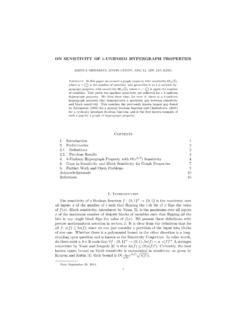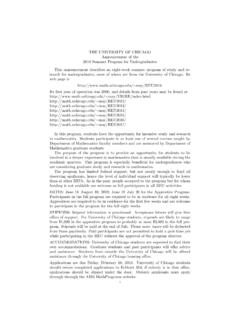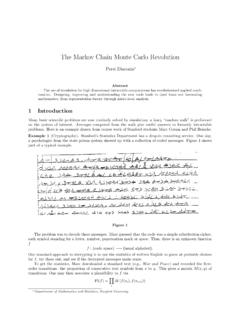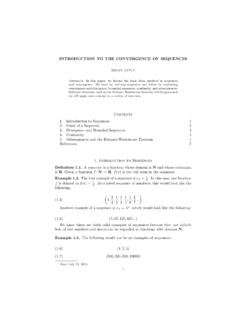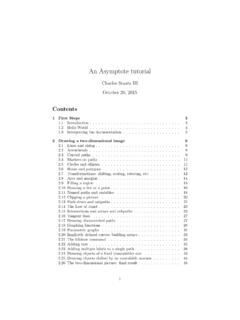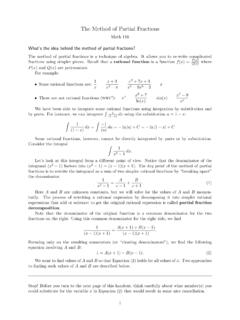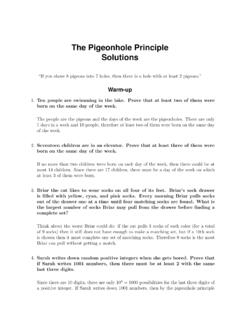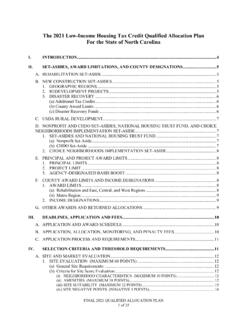Transcription of TOPOLOGY FROM DIFFERENTIABLE VIEWPOINT
1 TOPOLOGY FROM THE DIFFERENTIABLE VIEWPOINT By John W. Milnor Princeton University Based on notes by David W. Weaver The University Press of Virginia Charlottesville PREFACE THESE lectures were delivered at the University of Virginia in December 1963 under the sponsorship of the Page-Barbour Lecture Foundation. They present some topics from the beginnings of TOPOLOGY , centering about L. E. J. Brouwer s definition, in 1912, of the degree of a mapping. The methods used, however, are those of differential TOPOLOGY , rather than the combinatorial methods of Brouwer.
2 The concept of regular value and the theorem of Sard and Brown, which asserts that every smooth mapping has regular values, play a central role. To simplify the presentation, all manifolds are taken to be infinitely DIFFERENTIABLE and to be explicitly embedded in euclidean space. A small amount of point-set TOPOLOGY and of real variable theory is taken for granted. I would like here to express my gratitude to David Weaver, whose untimely death has saddened us all. His excellent set of notes made this manuscript possible. J. W.
3 M. Princeton, New Jersey March 1965 vii CONTENTS Preface Smooth manifolds and smooth maps Tangent spaces and derivatives Regular values The fundamental theorem of algebra Manifolds with boundary The Brouwer fixed point theorem 1. 2. The theorem of Sard and Brown 3. Proof of Sard s theorem 4. 5. Oriented manifolds The degree modulo 2 of a mapping Smooth homotopy and smooth isotopy The Brouwer degree 6. 7. 8. Exercises Vector fields and the Euler number Framed cobordism; the Pontryagin construction The Hopf theorem Appendix: Classifying l-manifolds Bibliography Index ix v11 1 2 7 8 10 12 13 16 20 20 26 27 32 42 50 52 5 5 59 63 I J Q1.
4 SMOOTH MANIFOLDS AND SMOOTH MAPS FIRST let us explain some of our terms. Rk denotes the k-dimensional euclidean space; thus a point x E Rk is an k-tuple x = (xi, .. , xk) of real numbers. Let U C Rk and V C R' be open sets. A mapping f from U to V (written f : U .+ V) is called smooth if all of the partial derivatives ay/ax,, . - - ax, exist and are continuous. More generally let X C Rk and Y C R' be arbitrary subsets of euclidean spaces. A map f : X ---f Y is called smooth if for each x E X there exist an open set U C Rk containing x and a smooth mapping F : U --f R1 that coincides with f throughout U A X.
5 If f : X + Y and g : Y -+ 2 are smooth, note that the composition g o f : X + 2 is also smooth. The identity map of any set X is auto- matically smooth. DEFINITION. A map f : X --f Y is called a di$eomorphisnz if f carries X homeomorphically onto Y and if both f and f-' are smooth. We can now indicate roughly what diferential TOPOLOGY is about by saying that it studies those properties of a set X C Rh which are invariant under diffeomorphism. We do not, however, want to look at completely arbitrary sets X. The following definition singles out a particularly attractive and useful class.
6 DEFINITION. A subset ilf C Rk is called a smooth inanifold of dimension m if each x E Af has a neighborhood W A M that is diffeomorphic to an open subset U of the euclidean space R". Any particular diffeomorphism g : U --f W A Af is called a para- metrixation of the region W A M. (The inverse diffeomorphism W A AI + U is called a system of coordinates on W A M.) Q 1. Smooth manifolds Tangent spaces 3 t 1 Rm Figure 1. Parametrization of a region in IIf Sometimes we will need to look at manifolds of dimension zero. By definition, M is a manifold of dimension zero if each x E M has a neigh- borhood W n M consisting of x alone.
7 EXAMPLES. The unit sphere S2, consisting of all (2, y, z) E R3 with x2 + y2 + z2 = 1 is a smooth manifold of dimension 2. In fact the diff eomorphism (x, Y) + (x, Y, d1 - x2 - Y", for x2 + y2 < 1, parametrizes the region z > 0 of S2. By iritcrchanging the roles of x, y, z, and changing the signs of the variables, we obtain similar parametrizations of the regions x > 0, y > 0, x < 0, y < 0, and z < 0. Since these cover S2, it follows that S2 is a smooth manifold.. , x,,) with x: = 1 is a smooth manifold of dimension n - 1. For example So C R' is a manifold consisting of just two points.
8 A somewhat wilder example of a smooth manifold is given by the set of all (x, y) E R2 with x # 0 and y = sin(l/x). More generally the sphere Sn-' C R" consisting of all (xl, TANGENT SPACES AND DERIVATIVES To define the notion of derivative df, for a smooth map f : M + N of smooth manifolds, we first associate with each x E M C Rk a linear subspace TM, c Rk of dimension m called the tangent space of dd at x. Then df, will be a linear mapping from TM, to TN,, where y = f(x). Elements of the vector space TM, are called tangent vectors to llil at x.)
9 Intuitively one thinks of the m-dimensional hyperplane in Rk which best approximates 114 near x; then TM, is the hyperplane through the origin that is parallel to this. (Compare Figures 1 and 2.) Similarly one thinks of the nonhomogeneous linear mapping from the tangent hyperplane at x to the tangent hyperplane at y which best approxi- mates f. Translating both hyperplanes to the origin, one obtains dfz. Before giving the actual definition, we must study the special case of mappings between open sets. For any open set U C Rk the tangent space TU, is defined to be the entire vector space Rk.
10 For any smooth map f: U + V the derivatiue dfz ; Rk + R' is defined by the formula df,(h) = lim (f(x + th) - f(x))/t for x E U, h E Rk. Clearly df,(h) is a linear function of h. (In fact df, is just that linear mapping which corresponds to the 1 X k matrix (af Jaxi>, of first partial derivatives, evaluated at 2.) Here are two fundamental properties of the derivative operation: 1 (Chain rule). If f : U + V and g : V + W are smooth maps, with t-0 f(x) = y, then d(g 0 f& = dg, 0 dfz. In other words, to every commutative triangle rv\ r/\ U-w 9 Of of smooth maps between open subsets of Rk, R', Rnk there corresponds a commutative triangle of linear maps Rf R d 2RY 49 f)= 2.)

